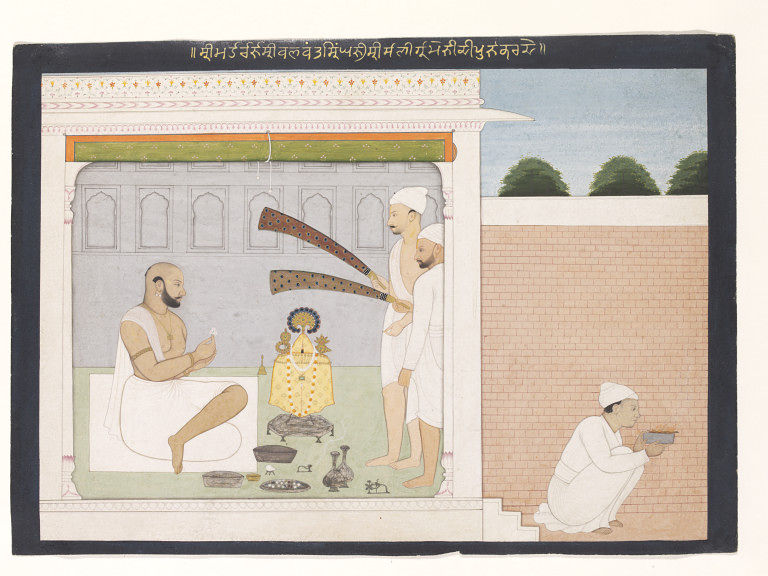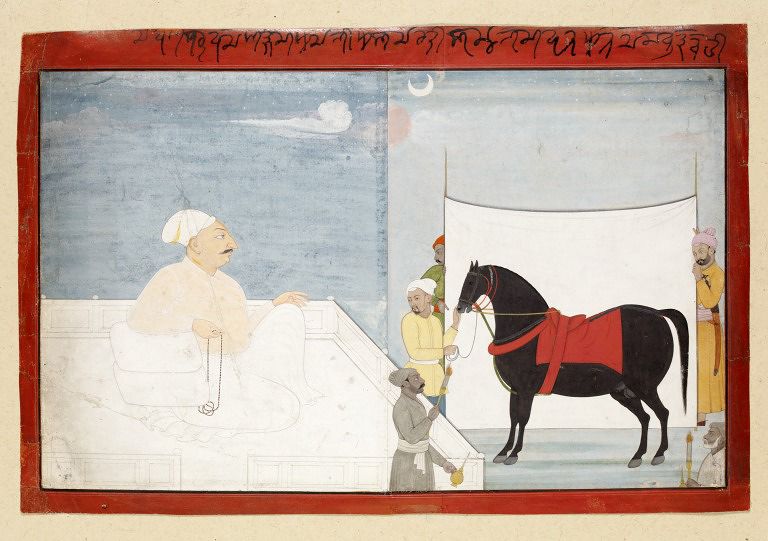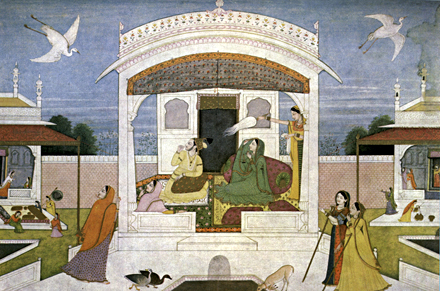|
Nainsukh
Nainsukh (literally "Joy of the Eyes"; c. 1710 – 1778) was an Indian painter. He was the younger son of the painter Pandit Seu and, like his older brother Manaku of Guler, was an important practitioner of Pahari painting, and has been called "one of the most original and brilliant of Indian painters". Around 1740 he left the family workshop in Guler and moved to Jasrota, where he painted most of his works for the local Rajput ruler Mian Zorowar Singh and his son Balwant Singh until the latter's death in 1763. This is the best known and documented phase of his career. Through his adaptation of elements of Mughal painting, he was a central force in the development of Pahari painting in the middle of the eighteenth century, bringing Mughal elements into what had been a school mainly concerned with Hindu religious subjects. In his final phase at Basholi, from about 1765 until his death in 1778, Nainsukh returned to religious subject matter, but retaining his stylistic in ... [...More Info...] [...Related Items...] OR: [Wikipedia] [Google] [Baidu] |
Nainsukh
Nainsukh (literally "Joy of the Eyes"; c. 1710 – 1778) was an Indian painter. He was the younger son of the painter Pandit Seu and, like his older brother Manaku of Guler, was an important practitioner of Pahari painting, and has been called "one of the most original and brilliant of Indian painters". Around 1740 he left the family workshop in Guler and moved to Jasrota, where he painted most of his works for the local Rajput ruler Mian Zorowar Singh and his son Balwant Singh until the latter's death in 1763. This is the best known and documented phase of his career. Through his adaptation of elements of Mughal painting, he was a central force in the development of Pahari painting in the middle of the eighteenth century, bringing Mughal elements into what had been a school mainly concerned with Hindu religious subjects. In his final phase at Basholi, from about 1765 until his death in 1778, Nainsukh returned to religious subject matter, but retaining his stylistic in ... [...More Info...] [...Related Items...] OR: [Wikipedia] [Google] [Baidu] |
Nainsukh 2009BY1327 Jpg L
Nainsukh (literally "Joy of the Eyes"; c. 1710 – 1778) was an Indian painter. He was the younger son of the painter Pandit Seu and, like his older brother Manaku of Guler, was an important practitioner of Pahari painting, and has been called "one of the most original and brilliant of Indian painters". Around 1740 he left the family workshop in Guler and moved to Jasrota, where he painted most of his works for the local Rajput ruler Mian Zorowar Singh and his son Balwant Singh until the latter's death in 1763. This is the best known and documented phase of his career. Through his adaptation of elements of Mughal painting, he was a central force in the development of Pahari painting in the middle of the eighteenth century, bringing Mughal elements into what had been a school mainly concerned with Hindu religious subjects. In his final phase at Basholi, from about 1765 until his death in 1778, Nainsukh returned to religious subject matter, but retaining his stylistic inno ... [...More Info...] [...Related Items...] OR: [Wikipedia] [Google] [Baidu] |
Nainsukh 2013GB2044 Jpg L
Nainsukh (literally "Joy of the Eyes"; c. 1710 – 1778) was an Indian painter. He was the younger son of the painter Pandit Seu and, like his older brother Manaku of Guler, was an important practitioner of Pahari painting, and has been called "one of the most original and brilliant of Indian painters". Around 1740 he left the family workshop in Guler and moved to Jasrota, where he painted most of his works for the local Rajput ruler Mian Zorowar Singh and his son Balwant Singh until the latter's death in 1763. This is the best known and documented phase of his career. Through his adaptation of elements of Mughal painting, he was a central force in the development of Pahari painting in the middle of the eighteenth century, bringing Mughal elements into what had been a school mainly concerned with Hindu religious subjects. In his final phase at Basholi, from about 1765 until his death in 1778, Nainsukh returned to religious subject matter, but retaining his stylistic inno ... [...More Info...] [...Related Items...] OR: [Wikipedia] [Google] [Baidu] |
Nainsukh 2013GB2062 Jpg L
Nainsukh (literally "Joy of the Eyes"; c. 1710 – 1778) was an Indian painter. He was the younger son of the painter Pandit Seu and, like his older brother Manaku of Guler, was an important practitioner of Pahari painting, and has been called "one of the most original and brilliant of Indian painters". Around 1740 he left the family workshop in Guler and moved to Jasrota, where he painted most of his works for the local Rajput ruler Mian Zorowar Singh and his son Balwant Singh until the latter's death in 1763. This is the best known and documented phase of his career. Through his adaptation of elements of Mughal painting, he was a central force in the development of Pahari painting in the middle of the eighteenth century, bringing Mughal elements into what had been a school mainly concerned with Hindu religious subjects. In his final phase at Basholi, from about 1765 until his death in 1778, Nainsukh returned to religious subject matter, but retaining his stylistic inno ... [...More Info...] [...Related Items...] OR: [Wikipedia] [Google] [Baidu] |
Amit Dutta
Amit Dutta (born 5 September 1977 in Jammu) is an Indian experimental filmmaker and writer. He is considered to be one of the most significant contemporary practitioners of experimental cinema, known for his distinctive style of filmmaking rooted in Indian aesthetic theories and personal symbolism resulting in images that are visually rich and acoustically stimulating. His works mostly deal with subjects of art history, ethno-anthropology and cultural inheritance through cinema, many times merging research and documentation with an open imagination. Life and career Amit Dutta graduated from the Film and Television Institute of India, Pune in 2004. He has taught at the National Institute of Design (NID), Ahmedabad. In 2015, he joined Indian Institute of Advanced Study (IIAS), Shimla as a Tagore fellow. Early works Amit Dutta began his career making several short experimental films which critics described as "without precedents except probably for a distant echo of Sergey Para ... [...More Info...] [...Related Items...] OR: [Wikipedia] [Google] [Baidu] |
Nainsukh (film)
''Nainsukh'' is a 2010 film directed by Amit Dutta based on the life and works of Nainsukh, an 18th-century Indian miniature painter. The film contains meticulous recreations of Nainsukh's paintings through compositions set amidst the ruins and environs of Jasrota palace. where the artist was retained. Cast * Manish Soni as Nainsukh * Nitin Goel as Raja Balwant Singh Release The film premiered at the 67th Venice International Film Festival, where it was received by Film Comment as one of top 10 films shown. Its North American premiere was at the San Francisco International Film Festival of 2011. Reception ''Nainsukh'' has received a great deal of appreciation from both film and art critics. Milo C. Beach wrote:The images of Nainsukh are stunning. The comparisons with the paintings could not be more clear, but what astonishes me most is the ability of Amit Dutta to compose those images, and even more, to light them. The lighting is breathtaking. It tells you why Nainsukh ... [...More Info...] [...Related Items...] OR: [Wikipedia] [Google] [Baidu] |
Manaku
Manaku of Guler or Manaku (c. 1700–1760) was an Indian painter from the Guler State, in modern-day Himachal Pradesh. After his death he was mostly forgotten and overshadowed by his much-celebrated younger brother Nainsukh. But today he is recognised as an exponent of Pahari style of painting, much like his brother. The rediscovery of Manaku has been a result of research efforts by art historians like B. N. Goswamy. Like Nainsukh, Manaku almost never signed his works, and only four extant works carry his signature. Gallery File:Golden cosmic egg Hiranyagarbha by Manaku.jpg, ''Hiranyagarbha (Golden Cosmic Egg)'', c. 1740, Opaque watercolour and gold on paper, Bharat Kala Bhavan, Varanasi File:Hiranyaksha use maya on varaha by manaku from Bhagavata purana series.jpg, ''Vishnu as Varaha challenges the demon Hiranyaksha'' from Bhagavata Purana series, c. 1740, Opaque watercolour and gold on paper, Government Museum and Art Gallery, Chandigarh File:Jayadeva bow to Radha-krishna. ... [...More Info...] [...Related Items...] OR: [Wikipedia] [Google] [Baidu] |
Manaku Of Guler
Manaku of Guler or Manaku (c. 1700–1760) was an Indian painter from the Guler State, in modern-day Himachal Pradesh. After his death he was mostly forgotten and overshadowed by his much-celebrated younger brother Nainsukh. But today he is recognised as an exponent of Pahari style of painting, much like his brother. The rediscovery of Manaku has been a result of research efforts by art historians like B. N. Goswamy. Like Nainsukh, Manaku almost never signed his works, and only four extant works carry his signature. Gallery File:Golden cosmic egg Hiranyagarbha by Manaku.jpg, ''Hiranyagarbha (Golden Cosmic Egg)'', c. 1740, Opaque watercolour and gold on paper, Bharat Kala Bhavan, Varanasi File:Hiranyaksha use maya on varaha by manaku from Bhagavata purana series.jpg, ''Vishnu as Varaha challenges the demon Hiranyaksha'' from Bhagavata Purana series, c. 1740, Opaque watercolour and gold on paper, Government Museum and Art Gallery, Chandigarh File:Jayadeva bow to Radha-krishna ... [...More Info...] [...Related Items...] OR: [Wikipedia] [Google] [Baidu] |
Pahari Painting
Pahari painting (literally meaning a painting from the mountainous regions: ''pahar'' means a mountain in Hindi) is an umbrella term used for a form of Indian painting, done mostly in miniature forms, originating from Himalayan hill kingdoms of North India, during 17th-19th century, notably Basohli, Mankot, Nurpur, Chamba, Kangra, Guler, Mandi and Garhwal. Nainsukh was a famous master of the mid-18th century, followed by his family workshop for another two generations. The central theme of Pahari painting is depiction of eternal love of Hindu deities Radha and Krishna. Origin and area The Pahari school developed and flourished during 17th-19th centuries stretching from Jammu to Garhwal, in the sub- Himalayan India, through Himachal Pradesh. Each created stark variations within the genre, ranging from bold intense Basohli Painting, originating from Basohli in Jammu and Kashmir, to the delicate and lyrical Kangra paintings, which became synonymous to the style before oth ... [...More Info...] [...Related Items...] OR: [Wikipedia] [Google] [Baidu] |
Raja Balwant Singh Of Jasrota Examining A Painting With Nainsukh
''Raja'' (; from , IAST ') is a royal title used for South Asian monarchs. The title is equivalent to king or princely ruler in South Asia and Southeast Asia. The title has a long history in South Asia and Southeast Asia, being attested from the Rigveda, where a ' is a ruler, see for example the ', the "Battle of Ten Kings". Raja-ruled Indian states While most of the Indian salute states (those granted a gun salute by the British Crown) were ruled by a Maharaja (or variation; some promoted from an earlier Raja- or equivalent style), even exclusively from 13 guns up, a number had Rajas: ; Hereditary salutes of 11-guns : * the Raja of Pindrawal * the Raja of Morni * the Raja of Rajouri * the Raja of Ali Rajpur * the Raja of Bilaspur * the Raja of Chamba * the Raja of Faridkot * the Raja of Jhabua * the Raja of Mandi * the Raja of Manipur * the Raja of Narsinghgarh * the Raja of Pudukkottai * the Raja of Rajgarh * the Raja of Sangli * the Raja of Sailana * the R ... [...More Info...] [...Related Items...] OR: [Wikipedia] [Google] [Baidu] |
Guler State
Guler was a small precolonial Indian hill state in the Lower Himalayas. Its capital was the town of Haripur Guler, in modern-day Himachal Pradesh. The kingdom was founded in 1415 by Raja Hari Chand, a scion of the ancient royal family of Kangra. Guler State is famous as the birthplace of Kangra painting in the first half of the 18th century when a family of Kashmiri painters trained in Mughal painting sought shelter at the court of Raja Dalip Singh (r. 1695–1741) of Guler. The rise of Guler Paintings or Guler style started in what is known as the early phase of Kangra art. History Early history According to legends, the Guler state was founded at an uncertain date between 1405 and 1450 by Raja Hari Chand. One fateful day, he fell into a dry well while hunting. Since no one could find him, the Raja was presumed dead and his brother was then named the Raja of Kangra State. When Raja Hari Chand was eventually brought back alive from the well, instead of fighting for his ri ... [...More Info...] [...Related Items...] OR: [Wikipedia] [Google] [Baidu] |
Haripur Guler
Haripur is a township in Kangra district in the Indian state of Himachal Pradesh. Haripur Guler are twin townships carrying the heritage of Guler Riyasat. A river separates the two towns which further makes Pong wetland, a Ramsar Wetalnd Site, home to a large number of migratory birds in winters because of marshes and the presence of irrigated private land. On the other side of Haripur town, is Guler which has a narrow gauge railway station connected from Pathankot station to Jogindernagar station. Formerly very prosperous and having a pool of talent, the township is now not able to provide jobs to its youngsters, forcing them to leave or to seek some informal job. The area can become a pool of the jobs if state and centre authorities will look into the potential of the area and its socio-cultural importance. History Guler State was a historical princely state in the area between 1405, when the state was founded, and 1813 when it was annexed by Punjab. Guler State was fam ... [...More Info...] [...Related Items...] OR: [Wikipedia] [Google] [Baidu] |







